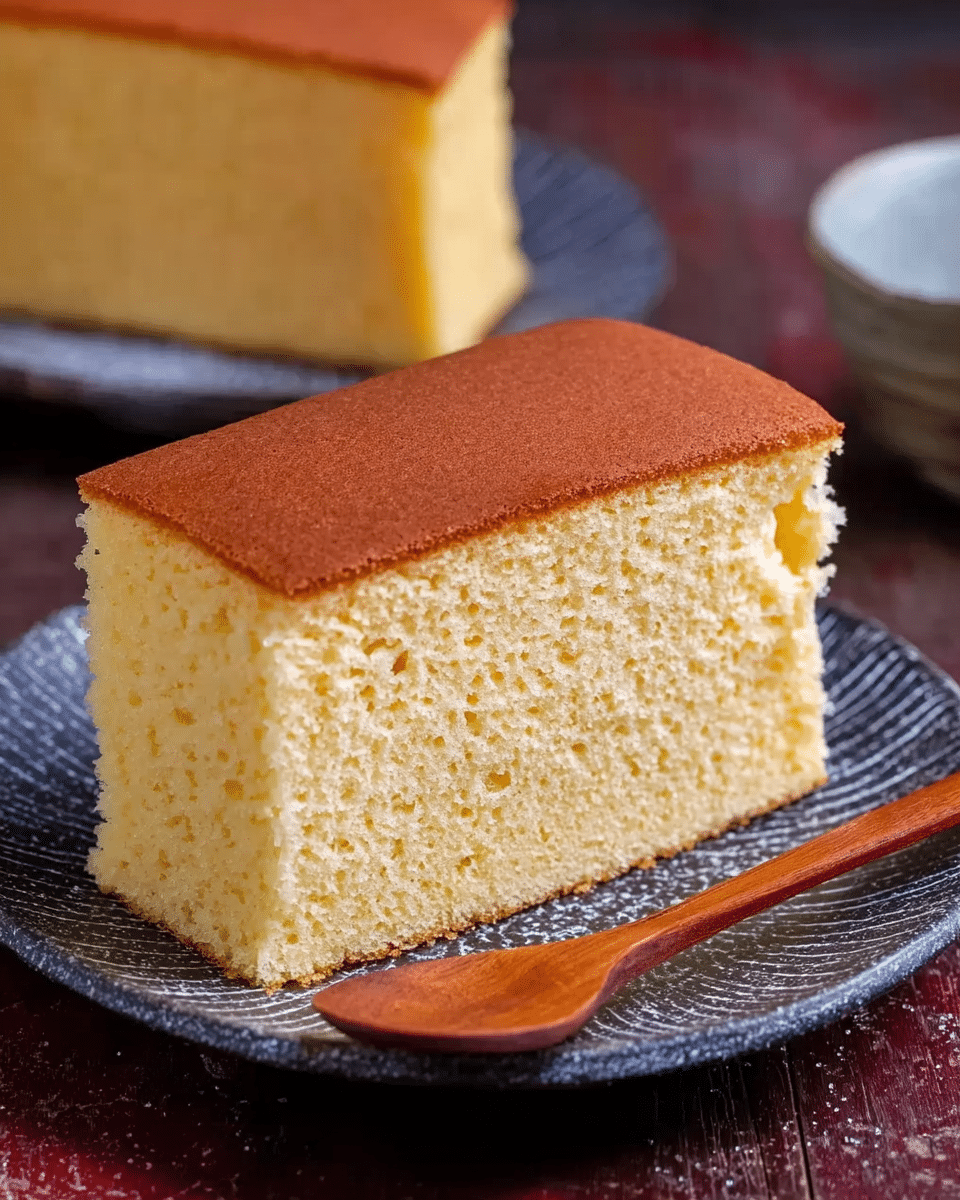Japanese Castella Cake, or Kasutera, is a moist, fluffy sponge cake with a golden top and a delicate, sweet flavor. Originating from Portugal and adapted in Japan over 400 years ago, it’s made without baking powder—its rise comes from whipped egg whites. This recipe combines bread flour for structure, cake flour for lightness, honey for a subtle floral note, and coarse sugar at the base for a gentle crunch. It’s perfect with tea and improves in flavor and texture after resting for a day.
Full Recipe:
Ingredients
-
1 tbsp coarse sugar (turbinado or similar)
-
100 g bread flour
-
20 g cake flour
-
3 egg whites (approx. 35 g each)
-
120 g white caster sugar
-
4 egg yolks (approx. 17 g each)
-
40 g honey
-
30 ml whole milk
-
30 ml neutral cooking oil (e.g., canola)
Directions
-
Preheat oven to 180°C (356°F). Line an 18 cm (7-inch) square cake pan with baking paper and sprinkle coarse sugar on the bottom. Sift bread and cake flour together.
-
In a clean bowl, whip egg whites on low/medium-low until foamy and doubled in size. Add sugar in 3–4 additions, incorporating fully each time. Increase to medium/medium-high speed until stiff peaks form.
-
Add egg yolks one at a time, whipping briefly to incorporate each. Drizzle in honey and whip for 10 seconds more.
-
Sift flour mixture into the batter one-third at a time, folding gently to preserve air.
-
In a small bowl, whisk milk and oil together. Add 2–3 tbsp batter to this mix, whisk, then pour over the main batter and fold in gently.
-
Pour batter into prepared pan. Use a skewer to draw zigzag lines horizontally and vertically across the top. Drop pan gently on the counter to remove air bubbles.
-
Place on top oven shelf and bake 1 minute. Remove, draw lines again, return to top shelf, and repeat twice more. After the third time, move to middle shelf, bake 7 minutes, then reduce heat to 160°C (320°F) and bake 30–40 minutes, checking from 25 minutes onward. Cake is done when a skewer comes out clean.
-
Drop the pan on the counter to prevent shrinking. Cool slightly, then wrap cake (with baking paper still on) in plastic wrap while warm. Place upside down in an airtight container and rest for 12–24 hours before slicing.
-
Trim edges, slice thickly, and serve.
Nutrients (per slice – 16 servings)
-
Calories: 100 kcal
-
Carbohydrates: 16 g
-
Protein: 2 g
-
Total Fat: 3 g
-
Saturated Fat: 1 g
-
Polyunsaturated Fat: 1 g
-
Monounsaturated Fat: 1 g
-
-
Cholesterol: 49 mg
-
Sodium: 13 mg
-
Potassium: 26 mg
-
Fiber: 0.2 g
-
Sugar: 10 g
-
Vitamin A: 68 IU
-
Vitamin C: 0.01 mg
-
Calcium: 10 mg
-
Iron: 0.2 mg
What Makes Castella Different from Other Sponge Cakes
Unlike many sponge cakes that rely on baking powder or other chemical leaveners, Castella’s rise comes entirely from air whipped into the egg whites. This technique produces a light, airy texture that’s both moist and bouncy, a combination that’s difficult to achieve with shortcuts. The use of both bread flour and cake flour strikes a balance between structure and tenderness, ensuring the cake holds its shape while remaining soft. A distinctive feature of this dessert is the layer of coarse sugar sprinkled on the bottom of the pan, which forms a subtle crunch that contrasts beautifully with the fluffy interior.
The Role of Honey in Flavor and Texture
Honey is one of the defining ingredients in Japanese Castella Cake. Beyond adding sweetness, it imparts a gentle floral note that lingers with each bite. It also plays a role in the cake’s moisture, helping to keep it tender over time. When the cake rests for a day after baking, the flavors deepen and the honey’s aromatic qualities become more pronounced, making it even more enjoyable the next day. This resting period is not just a tradition—it’s a deliberate step that enhances the overall eating experience.
Perfectly Balanced Ingredients
The combination of bread flour and cake flour is essential to Castella’s unique texture. Bread flour’s higher protein content provides strength and stability, while cake flour’s lower protein and finer texture contribute to softness. The neutral oil adds suppleness without altering the flavor, and the milk helps create a smooth, even crumb. Every component is chosen to contribute to the cake’s delicate structure and clean, refined taste.
A Cake That Rewards Patience
One of the most distinctive aspects of Castella preparation is the careful layering of technique. The eggs are separated and whipped with precision to incorporate just the right amount of air, the flour is sifted to prevent clumps, and the batter is folded with care to maintain volume. The baking process involves moving the cake between oven shelves and adjusting temperatures to ensure even rising and a perfectly golden surface. Once baked, the cake is wrapped while still warm and allowed to rest for 12–24 hours, which lets the moisture redistribute and the flavor develop. This patience is rewarded with a cake that’s markedly better the next day.
A Dessert with Visual Appeal
Presentation is an important part of Castella’s charm. The finished cake has a smooth, shiny, golden-brown top that contrasts beautifully with the pale yellow crumb. When sliced, each piece reveals an even, tight crumb structure without large air pockets—a testament to the care taken during mixing and baking. The coarse sugar at the base not only provides a pleasant crunch but also adds a touch of sparkle to each slice.
Pairing with Tea and Other Beverages
Castella’s subtle sweetness and delicate texture make it an ideal companion to tea, especially varieties like sencha, matcha, or hojicha. The slightly bitter notes of green tea balance the honeyed flavor of the cake. It also pairs well with coffee, particularly lighter roasts that won’t overpower its gentle taste. For a Western twist, it can be served with a dollop of whipped cream and fresh fruit, though many purists prefer to enjoy it plain to appreciate its understated elegance.
Variations and Regional Specialties
While the classic Castella is made with honey, regional variations across Japan introduce other flavors. In Nagasaki, where the cake first took root, you can find matcha Castella infused with green tea, or brown sugar versions that offer a deeper, molasses-like sweetness. Some bakers experiment with yuzu for a citrusy brightness or chocolate for a richer, dessert-like treat. These adaptations maintain the cake’s signature texture while offering new flavor experiences.
Why Resting Improves the Cake
The recommendation to let Castella rest overnight is more than a matter of tradition. During this time, the crumb becomes more cohesive, making slices cleaner and more uniform. The honey and sugar meld more thoroughly into the cake, producing a richer, more harmonious flavor. The moisture also distributes evenly, ensuring that no part of the cake feels dry. This quality makes Castella an excellent make-ahead dessert for special occasions, as it can be prepared the day before without sacrificing quality.
Serving for Special Occasions
Castella is often given as a gift in Japan, especially during holidays and formal visits. Its elegant appearance, refined taste, and ability to travel well make it a thoughtful choice. Wrapped in decorative paper or a simple box, it communicates care and hospitality. For gatherings, it can be sliced into thick, uniform pieces and arranged neatly on a platter for a refined presentation. Because it’s not overly sweet, it appeals to a wide range of palates, from children to adults.
Baking Tips for Success
While Castella is not difficult to make, it does require attention to detail. Using room temperature eggs ensures better volume when whipping. Sifting the flours together not only blends them evenly but also aerates them, helping maintain the cake’s lightness. Folding gently but thoroughly prevents deflating the batter while ensuring no streaks of flour remain. The zigzag lines drawn with a skewer before baking help the batter spread evenly and release air bubbles, resulting in a more uniform crumb.
A Cultural Symbol of Adaptation
Castella’s history reflects Japan’s openness to incorporating foreign culinary influences and making them its own. Introduced from Portugal but now deeply embedded in Japanese culture, it has evolved into a dessert that feels quintessentially Japanese. Its understated sweetness and refined presentation align perfectly with Japanese aesthetics, while its origins serve as a reminder of the centuries-old exchange between cultures.
Conclusion
Japanese Castella Cake is a dessert that embodies elegance, history, and meticulous craftsmanship. From its Portuguese roots to its modern Japanese identity, it has become a beloved treat that represents both cultural exchange and culinary refinement. Its signature combination of a moist, fluffy crumb, a golden top, and a gentle honey flavor makes it a timeless choice for tea time, gifting, or special occasions. Patience in its preparation and resting period rewards the baker with a cake that is as beautiful to look at as it is to eat. Whether you enjoy it plain, paired with tea, or adapted with regional flavors, Castella offers a quiet indulgence that lingers in memory long after the last bite.






